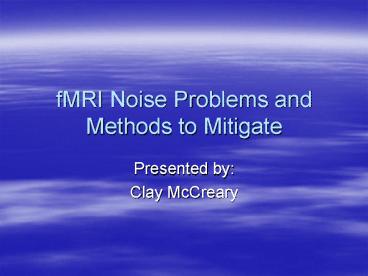fMRI Noise Problems and Methods to Mitigate - PowerPoint PPT Presentation
1 / 16
Title:
fMRI Noise Problems and Methods to Mitigate
Description:
There is equal energy in all octaves (or similar log bundles)[3] ... In terms of power at a constant bandwidth, 1/f noise falls off at 3dB per octave[3] ... – PowerPoint PPT presentation
Number of Views:62
Avg rating:3.0/5.0
Title: fMRI Noise Problems and Methods to Mitigate
1
fMRI Noise Problems and Methods to Mitigate
- Presented by
- Clay McCreary
2
Introduction
- Noise can affect an fMRI imaging session in two
ways - Creates artifacts in the image
- Strong acoustic noise interferes with the audio
stimuli (talking to the patient) used in imaging
experiments, and creates a harmful, annoying
environment for both the patient and the
staff4.
3
Creating Artifacts
- Drift Noise
- Reference 1 defines drift as low frequency
signal that varies slowly across the whole period
of the acquisition of the data caused by12 - Gross head motion
- Cerebrospinal fluid (CSF) pulsations
- Physiological fluctuations
- Local Magnetic susceptibility changes
- Image Noise
- Reference 1 has determined through observation
that the noise in fMRI has the characteristics of
fractional noise and exhibits long range
autocorrelation in time.
4
Fractional Noise
- Sometimes referred to as Pink Noise3
- Signal or process with a frequency spectrum such
that the power spectral density is proportional
to the reciprocal of the frequency3. - There is equal energy in all octaves (or similar
log bundles)3. - White noise has equal energy per hertz3
- In terms of power at a constant bandwidth, 1/f
noise falls off at 3dB per octave3.
5
Modeling Drift Noise
- Drift noise is assumed to vary slowly with large
scales1. - A discrete wavelet transform is used to model
drift noise1 - Fine scale wavelet coefficients will be zero
since drift noise is low frequency and thus does
not vary greatly over a short period of time.
6
Modeling Image and Acoustic Noise
- The image noise in the fMRI time series obtained
under the resting or null conditions exhibit
long-range autocorrelation in time and 1/f-like
spectral properties (fractional noise)1. - Acoustic noise is AWGN.
- Generated by the rapid switching of the scanner
coil to produce the strong magnetic field gradient
7
Methods to Solve Noise Problem
- Modified General Linear Model and Bayesian
Estimator1 - Blind Dereverberation for fMRI Noise Based on
SIMO Linear Prediction Method4 - LMS-based Active Noise Cancellation Methods for
fMRI Using Sub-band Filtering5
8
Modified General Linear Model and Bayesian
Estimator1
- Discrete wavelet decomposition is applied to the
signal. - yi ßbi fi ni, i 1, . . . , N (assumed LTI)
- yi is the fMRI signal at a specific voxel
- ß is a scalar estimation of the contribution of
the desired signal to yi - fi is the contribution of drift to yi
- ni is the contribution of noise to yi
9
Modified General Linear Model and Bayesian
Estimator1 (cont)
- Since fi is present only in large scale wavelets,
finer scales are used for this calculation
removing this term. - Applying an orthonormal wavelet process
decorrelates the noise and the wavelet
coefficients are normally distributed with zero
mean and identical variances at the same
levels1. - Bayesian estimator accurately determines the
noise covariance matrix thus ß is accurately
determined.
10
Blind Dereverberation for fMRI Noise Based on
SIMO Linear Prediction Method4
- Active noise cancellation (ANC) is used to
mitigate acoustic noise - Room reverberation degrades the performance of
the ANC - This method models the room as a single input
multiple output (SIMO) system using two
microphones to capture some of the reverberation
from the room.
11
Blind Dereverberation for fMRI Noise Based on
SIMO Linear Prediction Method4(cont)
- An algorithm based on a prediction method to
reduce the reverberation from the two
microphones output is used on the SIMO
system4. - The output of the microphones correlates with the
entire room reverberation. - The room reverberation is predicted and cancelled
without the room transfer function.
12
LMS-based Active Noise Cancellation Methods for
fMRI Using Sub-band Filtering5
- Using a least mean squared (LMS) finite impulse
response (FIR) filter over the entire band of
acoustic noise produced by the fMRI will result
in a heavy computational load and significant
time delay.
13
LMS-based Active Noise Cancellation Methods for
fMRI Using Sub-band Filtering5(cont)
- Dividing the acoustic band into subbands and
implementing LMS-FIR filters on each subband then
combining them using a stacking method allows
for less computational load and nearly real time
results. - Since the subband method is essentially
delayless it provides a more effective means of
ANC.
14
References
- 1 Huaien Luo and Sadasivan Puthusserypady,
Analysis of fMRI Data With Drift Modified
General Linear Model and Bayesian Estimator,
IEEE TRANSACTIONS ON BIOMEDICAL ENGINEERING, VOL.
55, NO. 5, pp. 1504-1511, May 2008 - 2 T. Kim, L. Al-Dayeh, and M. Singh, FMRI
Artifacts Reduction Using Bayesian Image
Processing, IEEE TRANSACTIONS ON NUCLEAR
SCIENCE, VOL. 46, NO. 6, pp. 2134-2140, DECEMBER
1999
15
References (cont)
- 3 Wikipedia, Pink Noise, Retrieved from the
world wide web, June 7, 2008 from
http//en.wikipedia.org/wiki/1/f_noise - 4 Hua Bao, Issa M.S. Panahi, Richard Briggs,
Blind Dereverberation for fMRI Noise Based on
SIMO Linear Prediction Method, Proceedings of
the 29th Annual International Conference of the
IEEE EMBS Cité Internationale, Lyon, France, pp.
2831-2834, 2007
16
References (cont)
- 5 Ali A. Milani, Student Member. Issa Panahi,
Richard Briggs, LMS-based Active Noise
Cancellation Methods for fMRI Using Sub-band
Filtering, Proceedings of the 28th IEEE EMBS
Annual International Conference New York City,
USA, pp. 513-516, Aug 30-Sept 3, 2006































